2017 NISSAN ROGUE HYBRID engine coolant
[x] Cancel search: engine coolantPage 16 of 520
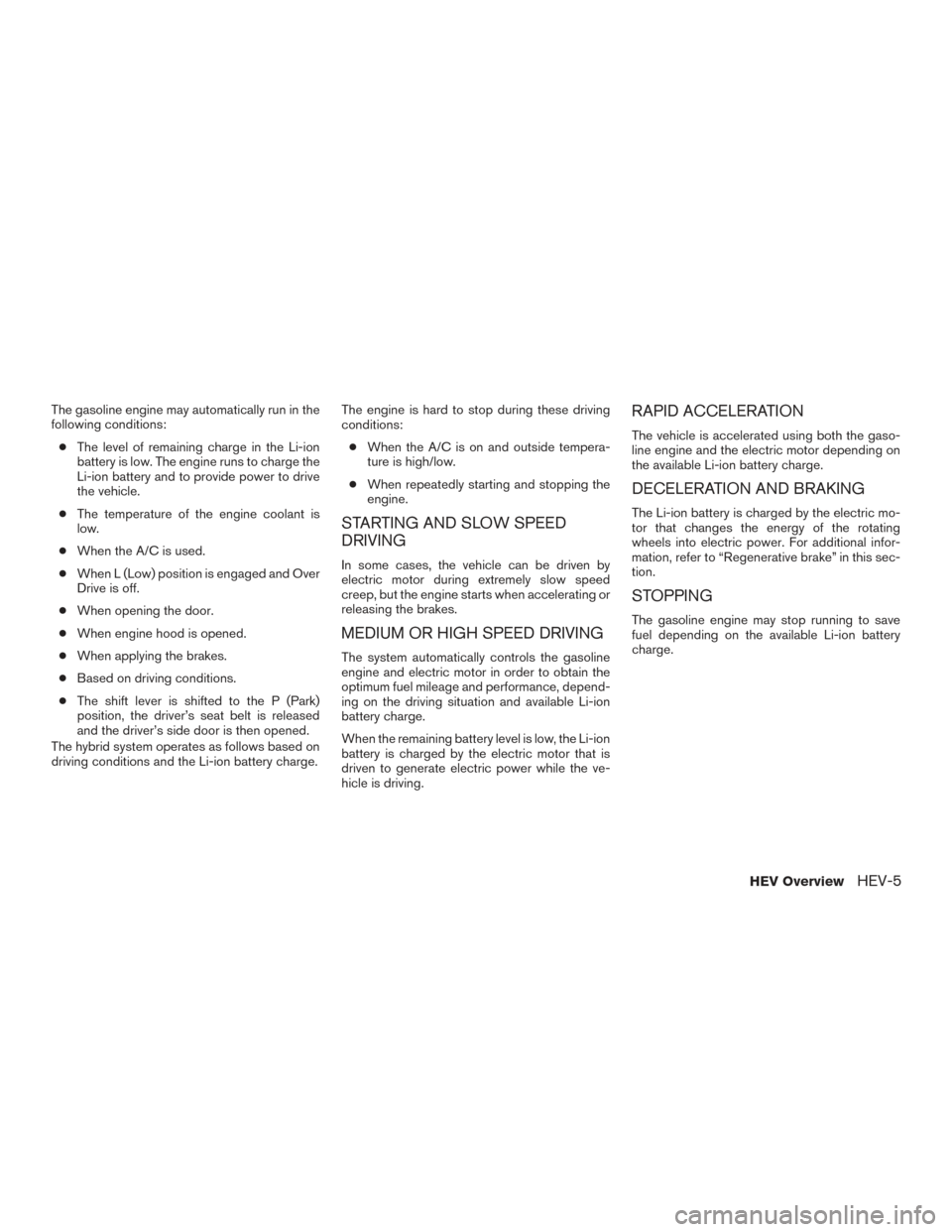
The gasoline engine may automatically run in the
following conditions:● The level of remaining charge in the Li-ion
battery is low. The engine runs to charge the
Li-ion battery and to provide power to drive
the vehicle.
● The temperature of the engine coolant is
low.
● When the A/C is used.
● When L (Low) position is engaged and Over
Drive is off.
● When opening the door.
● When engine hood is opened.
● When applying the brakes.
● Based on driving conditions.
● The shift lever is shifted to the P (Park)
position, the driver’s seat belt is released
and the driver’s side door is then opened.
The hybrid system operates as follows based on
driving conditions and the Li-ion battery charge. The engine is hard to stop during these driving
conditions:
● When the A/C is on and outside tempera-
ture is high/low.
● When repeatedly starting and stopping the
engine.
STARTING AND SLOW SPEED
DRIVING
In some cases, the vehicle can be driven by
electric motor during extremely slow speed
creep, but the engine starts when accelerating or
releasing the brakes.
MEDIUM OR HIGH SPEED DRIVING
The system automatically controls the gasoline
engine and electric motor in order to obtain the
optimum fuel mileage and performance, depend-
ing on the driving situation and available Li-ion
battery charge.
When the remaining battery level is low, the Li-ion
battery is charged by the electric motor that is
driven to generate electric power while the ve-
hicle is driving.
RAPID ACCELERATION
The vehicle is accelerated using both the gaso-
line engine and the electric motor depending on
the available Li-ion battery charge.
DECELERATION AND BRAKING
The Li-ion battery is charged by the electric mo-
tor that changes the energy of the rotating
wheels into electric power. For additional infor-
mation, refer to “Regenerative brake” in this sec-
tion.
STOPPING
The gasoline engine may stop running to save
fuel depending on the available Li-ion battery
charge.
HEV OverviewHEV-5
Page 35 of 520
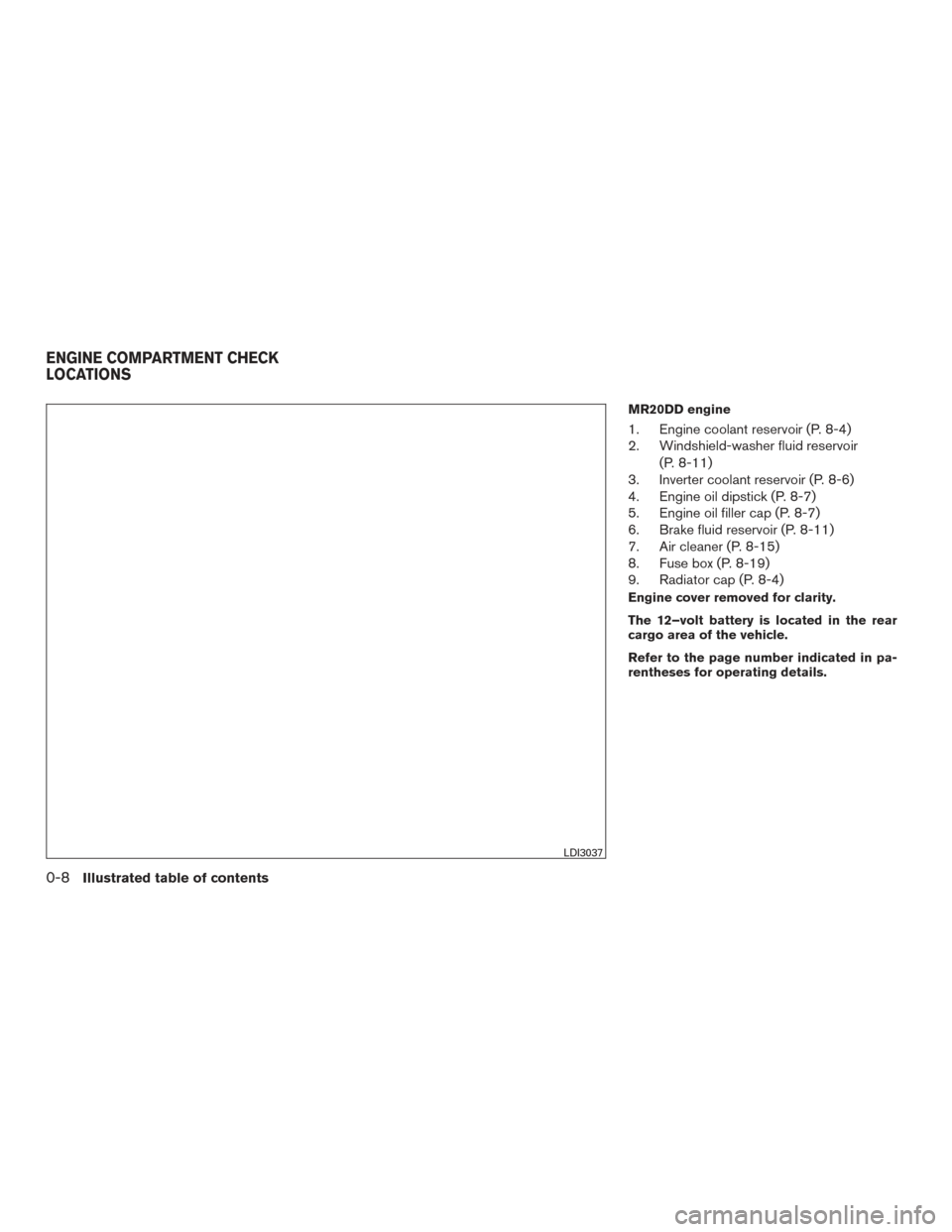
MR20DD engine
1. Engine coolant reservoir (P. 8-4)
2. Windshield-washer fluid reservoir(P. 8-11)
3. Inverter coolant reservoir (P. 8-6)
4. Engine oil dipstick (P. 8-7)
5. Engine oil filler cap (P. 8-7)
6. Brake fluid reservoir (P. 8-11)
7. Air cleaner (P. 8-15)
8. Fuse box (P. 8-19)
9. Radiator cap (P. 8-4)
Engine cover removed for clarity.
The 12–volt battery is located in the rear
cargo area of the vehicle.
Refer to the page number indicated in pa-
rentheses for operating details.
LDI3037
ENGINE COMPARTMENT CHECK
LOCATIONS
0-8Illustrated table of contents
Page 116 of 520
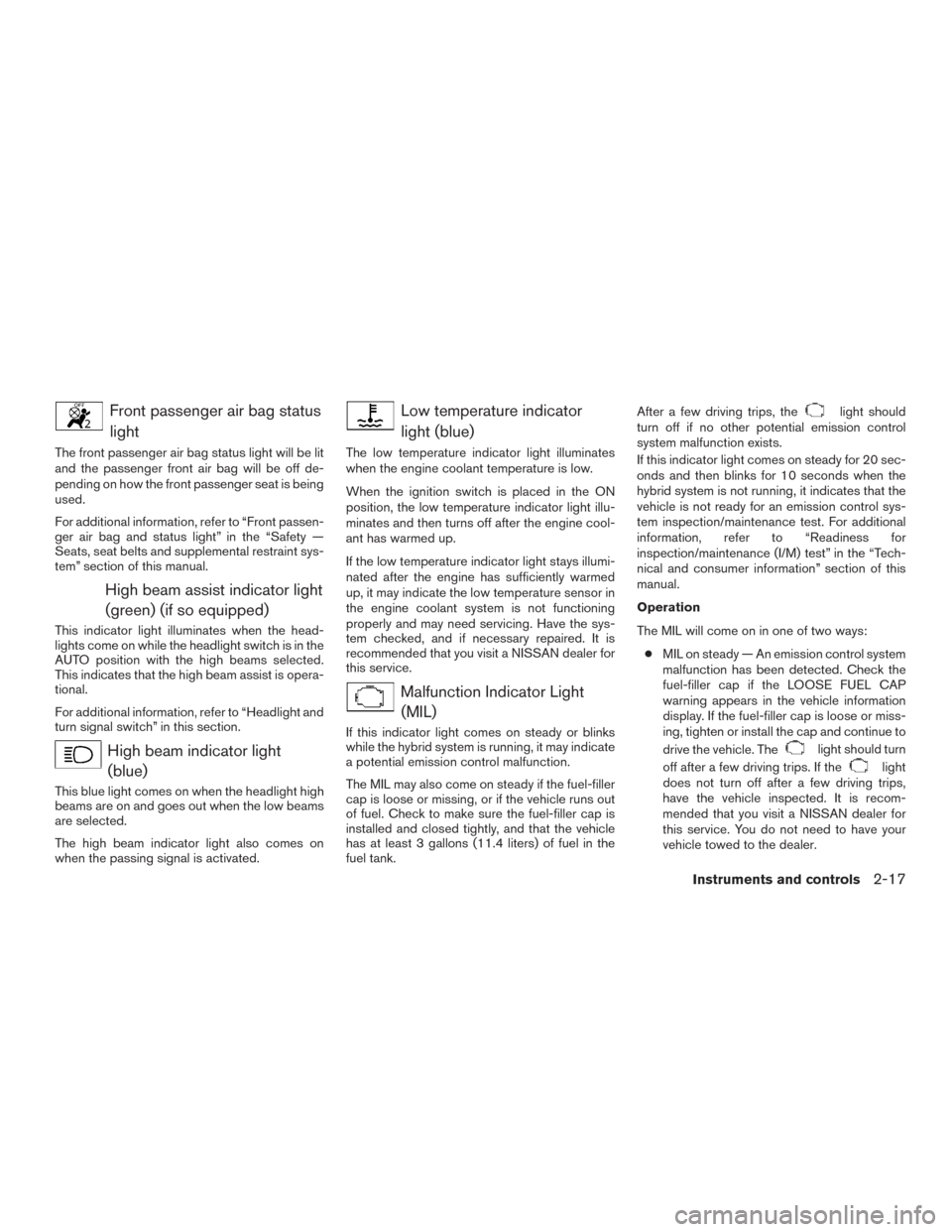
Front passenger air bag statuslight
The front passenger air bag status light will be lit
and the passenger front air bag will be off de-
pending on how the front passenger seat is being
used.
For additional information, refer to “Front passen-
ger air bag and status light” in the “Safety —
Seats, seat belts and supplemental restraint sys-
tem” section of this manual.
High beam assist indicator light(green) (if so equipped)
This indicator light illuminates when the head-
lights come on while the headlight switch is in the
AUTO position with the high beams selected.
This indicates that the high beam assist is opera-
tional.
For additional information, refer to “Headlight and
turn signal switch” in this section.
High beam indicator light(blue)
This blue light comes on when the headlight high
beams are on and goes out when the low beams
are selected.
The high beam indicator light also comes on
when the passing signal is activated.
Low temperature indicator
light (blue)
The low temperature indicator light illuminates
when the engine coolant temperature is low.
When the ignition switch is placed in the ON
position, the low temperature indicator light illu-
minates and then turns off after the engine cool-
ant has warmed up.
If the low temperature indicator light stays illumi-
nated after the engine has sufficiently warmed
up, it may indicate the low temperature sensor in
the engine coolant system is not functioning
properly and may need servicing. Have the sys-
tem checked, and if necessary repaired. It is
recommended that you visit a NISSAN dealer for
this service.
Malfunction Indicator Light(MIL)
If this indicator light comes on steady or blinks
while the hybrid system is running, it may indicate
a potential emission control malfunction.
The MIL may also come on steady if the fuel-filler
cap is loose or missing, or if the vehicle runs out
of fuel. Check to make sure the fuel-filler cap is
installed and closed tightly, and that the vehicle
has at least 3 gallons (11.4 liters) of fuel in the
fuel tank. After a few driving trips, the
light should
turn off if no other potential emission control
system malfunction exists.
If this indicator light comes on steady for 20 sec-
onds and then blinks for 10 seconds when the
hybrid system is not running, it indicates that the
vehicle is not ready for an emission control sys-
tem inspection/maintenance test. For additional
information, refer to “Readiness for
inspection/maintenance (I/M) test” in the “Tech-
nical and consumer information” section of this
manual.
Operation
The MIL will come on in one of two ways:
● MIL on steady — An emission control system
malfunction has been detected. Check the
fuel-filler cap if the LOOSE FUEL CAP
warning appears in the vehicle information
display. If the fuel-filler cap is loose or miss-
ing, tighten or install the cap and continue to
drive the vehicle. The
light should turn
off after a few driving trips. If the
light
does not turn off after a few driving trips,
have the vehicle inspected. It is recom-
mended that you visit a NISSAN dealer for
this service. You do not need to have your
vehicle towed to the dealer.
Instruments and controls2-17
Page 132 of 520
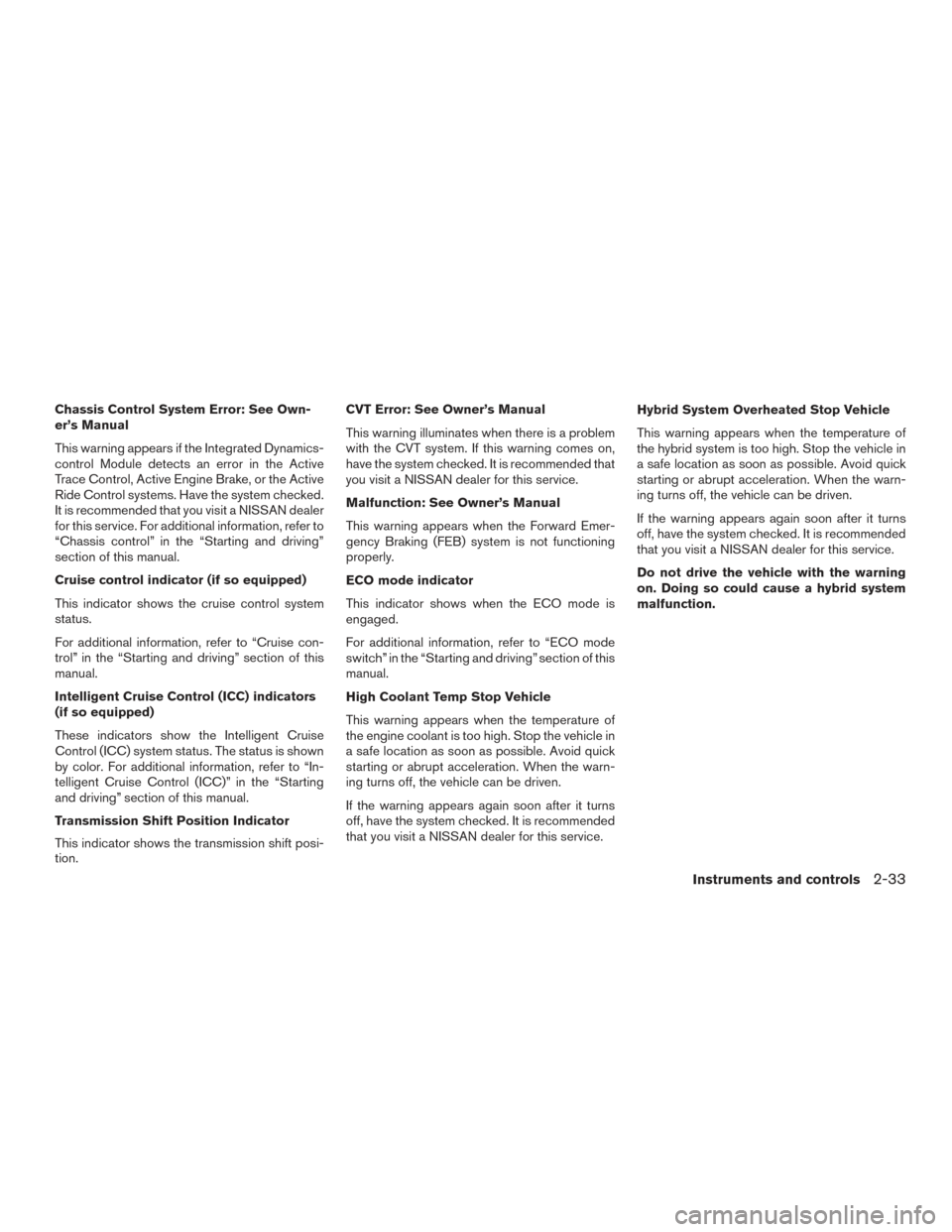
Chassis Control System Error: See Own-
er’s Manual
This warning appears if the Integrated Dynamics-
control Module detects an error in the Active
Trace Control, Active Engine Brake, or the Active
Ride Control systems. Have the system checked.
It is recommended that you visit a NISSAN dealer
for this service. For additional information, refer to
“Chassis control” in the “Starting and driving”
section of this manual.
Cruise control indicator (if so equipped)
This indicator shows the cruise control system
status.
For additional information, refer to “Cruise con-
trol” in the “Starting and driving” section of this
manual.
Intelligent Cruise Control (ICC) indicators
(if so equipped)
These indicators show the Intelligent Cruise
Control (ICC) system status. The status is shown
by color. For additional information, refer to “In-
telligent Cruise Control (ICC)” in the “Starting
and driving” section of this manual.
Transmission Shift Position Indicator
This indicator shows the transmission shift posi-
tion.CVT Error: See Owner’s Manual
This warning illuminates when there is a problem
with the CVT system. If this warning comes on,
have the system checked. It is recommended that
you visit a NISSAN dealer for this service.
Malfunction: See Owner’s Manual
This warning appears when the Forward Emer-
gency Braking (FEB) system is not functioning
properly.
ECO mode indicator
This indicator shows when the ECO mode is
engaged.
For additional information, refer to “ECO mode
switch” in the “Starting and driving” section of this
manual.
High Coolant Temp Stop Vehicle
This warning appears when the temperature of
the engine coolant is too high. Stop the vehicle in
a safe location as soon as possible. Avoid quick
starting or abrupt acceleration. When the warn-
ing turns off, the vehicle can be driven.
If the warning appears again soon after it turns
off, have the system checked. It is recommended
that you visit a NISSAN dealer for this service.
Hybrid System Overheated Stop Vehicle
This warning appears when the temperature of
the hybrid system is too high. Stop the vehicle in
a safe location as soon as possible. Avoid quick
starting or abrupt acceleration. When the warn-
ing turns off, the vehicle can be driven.
If the warning appears again soon after it turns
off, have the system checked. It is recommended
that you visit a NISSAN dealer for this service.
Do not drive the vehicle with the warning
on. Doing so could cause a hybrid system
malfunction.
Instruments and controls2-33
Page 402 of 520

●The hill start assist system is not de-
signed to hold the vehicle at a standstill
on a hill. Depress the brake pedal when
the vehicle is stopped on a steep hill.
Failure to do so may cause the vehicle
to roll backwards and may result in a
collision or serious personal injury.
● The hill start assist may not prevent the
vehicle from rolling backwards on a hill
under all load or road conditions. Al-
ways be prepared to depress the brake
pedal to prevent the vehicle from rolling
backwards. Failure to do so may result
in a collision or serious personal injury.
When the vehicle is stopped on a hill, the hill start
assist system automatically keeps the brakes ap-
plied. This helps prevent the vehicle from rolling
backward in the time it takes the driver to release
the brake pedal and apply the accelerator.
Hill start assist will operate automatically under
the following conditions: ● The shift lever is shifted to a forward or
reverse gear.
● The vehicle is stopped completely on a hill
by applying the brake. The maximum holding time is two seconds. After
two seconds the vehicle will begin to roll back
and hill start assist will stop operating completely.
Hill start assist will not operate when the shift
lever is shifted into N (Neutral) or P (Park) or on a
flat and level road.FREEING A FROZEN DOOR LOCK
To prevent a door lock from freezing, apply de-
icer through the key hole. If the lock becomes
frozen, heat the key before inserting it into the key
hole, or use the NISSAN Intelligent Key®.
ANTIFREEZE
In the winter when it is anticipated that the tem-
perature will drop below 32°F (0°C) , check the
antifreeze to assure proper winter protection. For
additional information, refer to “Engine cooling
system” in the “Do-it-yourself” section of this
manual.
12–VOLT BATTERY
If the 12–volt battery is not fully charged during
extremely cold weather conditions, the battery
fluid may freeze and damage the battery. To main-
tain maximum efficiency, the 12–volt battery
should be checked regularly. For additional infor-
mation, refer to “Battery” in the “Do-it-yourself”
section of this manual.
DRAINING OF COOLANT WATER
If the vehicle is to be left outside without anti-
freeze, drain the cooling system, including the
engine block. Refill before operating the vehicle.
COLD WEATHER DRIVING
Starting and driving5-97
Page 403 of 520
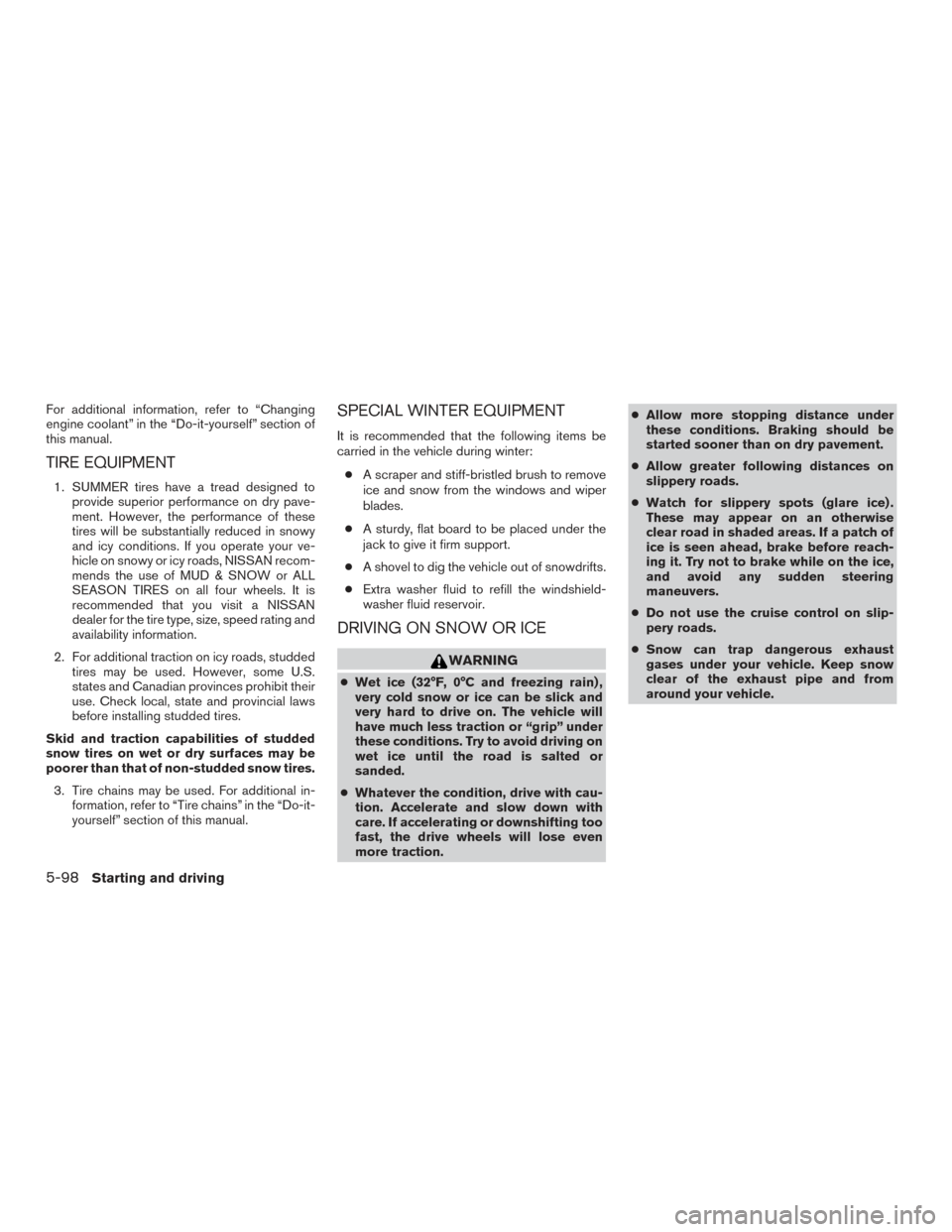
For additional information, refer to “Changing
engine coolant” in the “Do-it-yourself” section of
this manual.
TIRE EQUIPMENT
1. SUMMER tires have a tread designed toprovide superior performance on dry pave-
ment. However, the performance of these
tires will be substantially reduced in snowy
and icy conditions. If you operate your ve-
hicle on snowy or icy roads, NISSAN recom-
mends the use of MUD & SNOW or ALL
SEASON TIRES on all four wheels. It is
recommended that you visit a NISSAN
dealer for the tire type, size, speed rating and
availability information.
2. For additional traction on icy roads, studded tires may be used. However, some U.S.
states and Canadian provinces prohibit their
use. Check local, state and provincial laws
before installing studded tires.
Skid and traction capabilities of studded
snow tires on wet or dry surfaces may be
poorer than that of non-studded snow tires. 3. Tire chains may be used. For additional in- formation, refer to “Tire chains” in the “Do-it-
yourself” section of this manual.
SPECIAL WINTER EQUIPMENT
It is recommended that the following items be
carried in the vehicle during winter:
● A scraper and stiff-bristled brush to remove
ice and snow from the windows and wiper
blades.
● A sturdy, flat board to be placed under the
jack to give it firm support.
● A shovel to dig the vehicle out of snowdrifts.
● Extra washer fluid to refill the windshield-
washer fluid reservoir.
DRIVING ON SNOW OR ICE
WARNING
●Wet ice (32°F, 0°C and freezing rain) ,
very cold snow or ice can be slick and
very hard to drive on. The vehicle will
have much less traction or “grip” under
these conditions. Try to avoid driving on
wet ice until the road is salted or
sanded.
● Whatever the condition, drive with cau-
tion. Accelerate and slow down with
care. If accelerating or downshifting too
fast, the drive wheels will lose even
more traction. ●
Allow more stopping distance under
these conditions. Braking should be
started sooner than on dry pavement.
● Allow greater following distances on
slippery roads.
● Watch for slippery spots (glare ice) .
These may appear on an otherwise
clear road in shaded areas. If a patch of
ice is seen ahead, brake before reach-
ing it. Try not to brake while on the ice,
and avoid any sudden steering
maneuvers.
● Do not use the cruise control on slip-
pery roads.
● Snow can trap dangerous exhaust
gases under your vehicle. Keep snow
clear of the exhaust pipe and from
around your vehicle.
5-98Starting and driving
Page 418 of 520
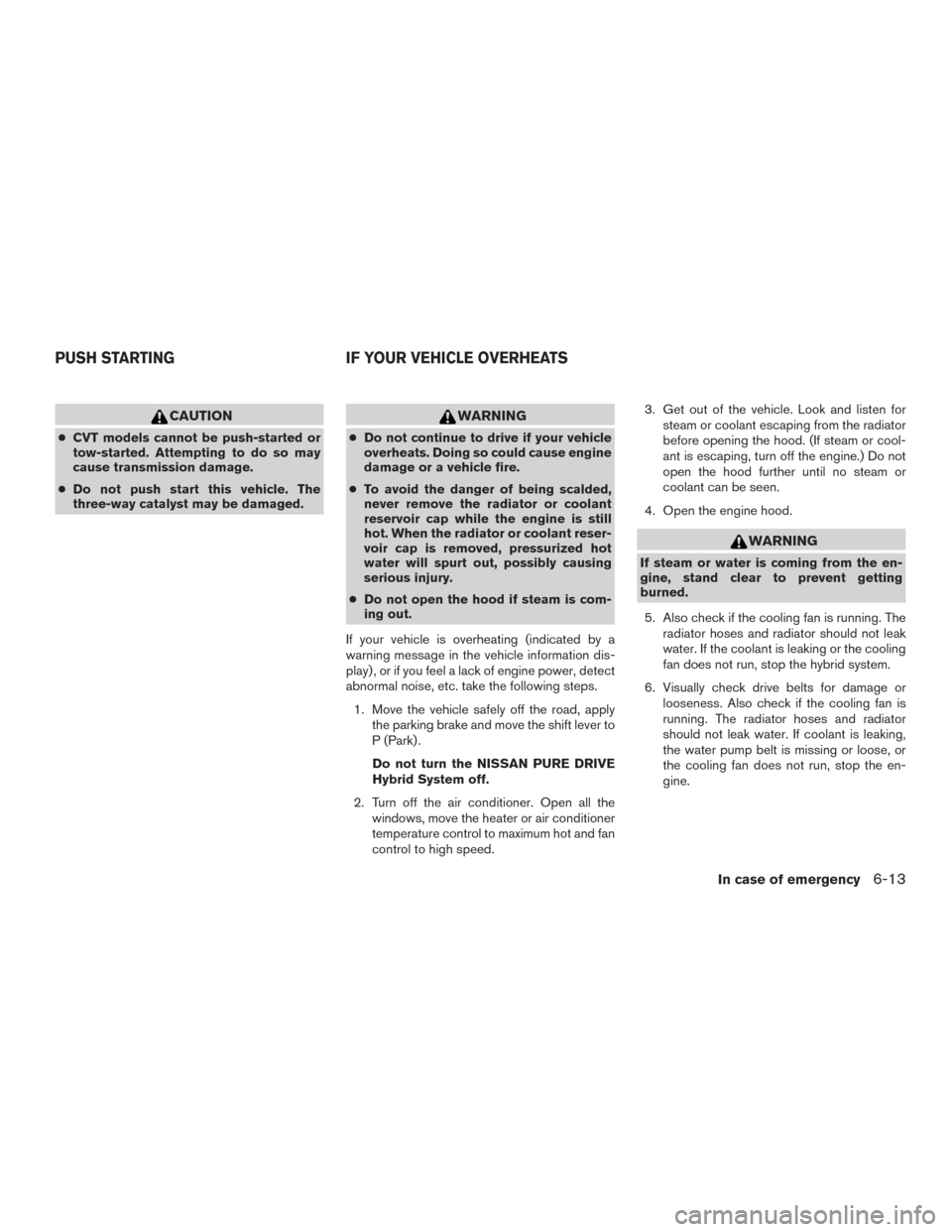
CAUTION
●CVT models cannot be push-started or
tow-started. Attempting to do so may
cause transmission damage.
● Do not push start this vehicle. The
three-way catalyst may be damaged.
WARNING
●Do not continue to drive if your vehicle
overheats. Doing so could cause engine
damage or a vehicle fire.
● To avoid the danger of being scalded,
never remove the radiator or coolant
reservoir cap while the engine is still
hot. When the radiator or coolant reser-
voir cap is removed, pressurized hot
water will spurt out, possibly causing
serious injury.
● Do not open the hood if steam is com-
ing out.
If your vehicle is overheating (indicated by a
warning message in the vehicle information dis-
play) , or if you feel a lack of engine power, detect
abnormal noise, etc. take the following steps. 1. Move the vehicle safely off the road, apply the parking brake and move the shift lever to
P (Park) .
Do not turn the NISSAN PURE DRIVE
Hybrid System off.
2. Turn off the air conditioner. Open all the windows, move the heater or air conditioner
temperature control to maximum hot and fan
control to high speed. 3. Get out of the vehicle. Look and listen for
steam or coolant escaping from the radiator
before opening the hood. (If steam or cool-
ant is escaping, turn off the engine.) Do not
open the hood further until no steam or
coolant can be seen.
4. Open the engine hood.
WARNING
If steam or water is coming from the en-
gine, stand clear to prevent getting
burned.
5. Also check if the cooling fan is running. The radiator hoses and radiator should not leak
water. If the coolant is leaking or the cooling
fan does not run, stop the hybrid system.
6. Visually check drive belts for damage or looseness. Also check if the cooling fan is
running. The radiator hoses and radiator
should not leak water. If coolant is leaking,
the water pump belt is missing or loose, or
the cooling fan does not run, stop the en-
gine.
PUSH STARTING IF YOUR VEHICLE OVERHEATS
In case of emergency6-13
Page 419 of 520

WARNING
Be careful not to allow your hands, hair,
jewelry or clothing to come into contact
with, or get caught in, engine belts or the
engine cooling fan. The engine cooling fan
can start at any time.7. After the engine cools down, check the cool- ant level in the engine coolant reservoir tank
with the engine running. Add coolant to the
engine coolant reservoir tank if necessary.
Have your vehicle repaired. It is recom-
mended that you visit a NISSAN dealer for
this service. When towing your vehicle, all jurisdictional and
local regulations for towing must be followed.
Incorrect towing equipment could damage your
vehicle. Towing instructions are available from a
NISSAN dealer. Local service operators are gen-
erally familiar with the applicable laws and proce-
dures for towing. To assure proper towing and to
prevent accidental damage to your vehicle,
NISSAN recommends having a service operator
tow your vehicle. It is advisable to have the ser-
vice operator carefully read the following precau-
tions:
WARNING
●
Never ride in a vehicle that is being
towed.
● Never get under your vehicle after it has
been lifted by a tow truck.
CAUTION
●When towing, make sure that the trans-
mission, axles, steering system and
powertrain are in working condition. If
any of these conditions apply, dollies or
a flatbed tow truck must be used.
● Always attach safety chains before
towing. For additional information about towing your front
wheel drive vehicle behind a Recreational Vehicle
(RV) , refer to “Flat towing for front wheel drive
vehicle” in the “Technical and consumer informa-
tion” section of this manual.
For additional information about towing your all-
wheel drive vehicle behind a Recreational Vehicle
(RV) , refer to “Flat towing for all-wheel drive
vehicle” in the “Technical and consumer informa-
tion” section of this manual.
TOWING RECOMMENDED BY
NISSAN
NISSAN recommends towing your vehicle based
upon the type of drivetrain. Please refer to the
diagrams in this section to ensure that your ve-
hicle is properly towed.
TOWING YOUR VEHICLE
6-14In case of emergency